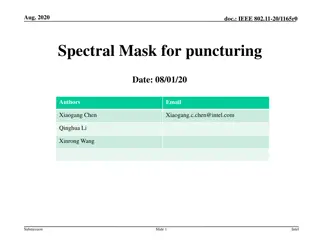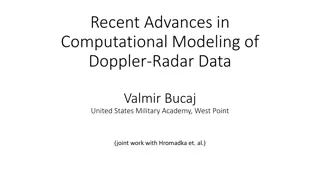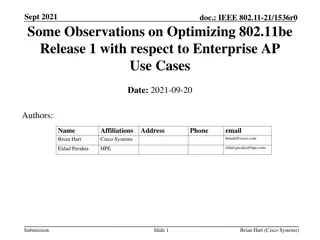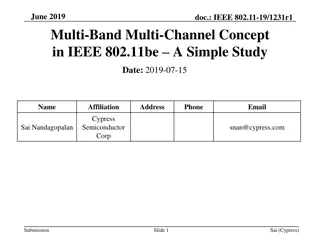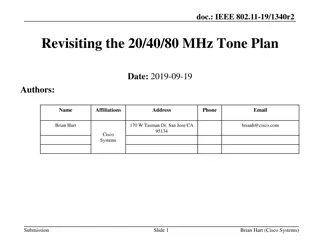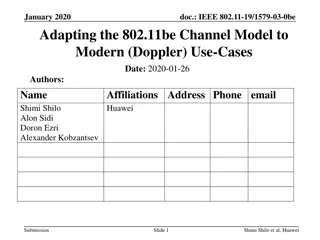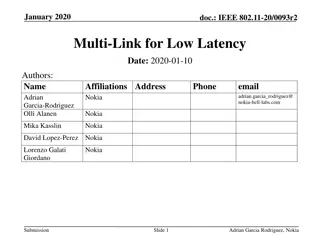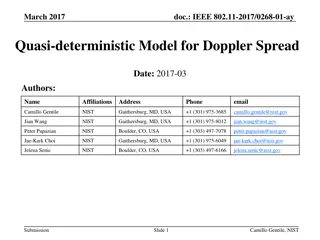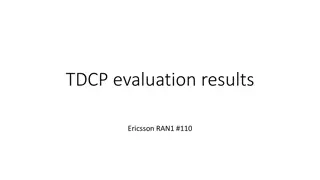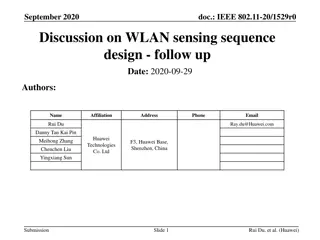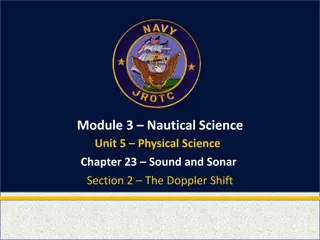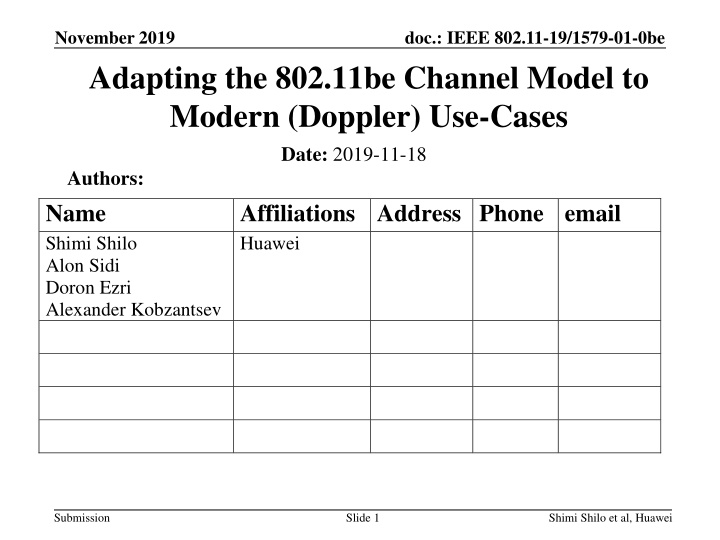
Adapting the 802.11be Channel Model to Modern Doppler Use-Cases
Explore the adaptation of the 802.11be channel model to modern Doppler use-cases, considering the impact of environmental movements on wireless communication in various scenarios such as convention centers, airports, and schools. Lab measurements show the Doppler Power Spectral Density (PSD) with movements, providing insights for evaluating performance schemes realistically.
Download Presentation

Please find below an Image/Link to download the presentation.
The content on the website is provided AS IS for your information and personal use only. It may not be sold, licensed, or shared on other websites without obtaining consent from the author. If you encounter any issues during the download, it is possible that the publisher has removed the file from their server.
You are allowed to download the files provided on this website for personal or commercial use, subject to the condition that they are used lawfully. All files are the property of their respective owners.
The content on the website is provided AS IS for your information and personal use only. It may not be sold, licensed, or shared on other websites without obtaining consent from the author.
E N D
Presentation Transcript
November 2019 Adapting the 802.11be Channel Model to Modern (Doppler) Use-Cases Date: 2019-11-18 Authors: doc.: IEEE 802.11-19/1579-01-0be Name Shimi Shilo Alon Sidi Doron Ezri Alexander Kobzantsev Affiliations Address Phone email Huawei Submission Slide 1 Shimi Shilo et al, Huawei
November 2019 doc.: IEEE 802.11-19/1579-01-0be Introduction The TGn indoor channel models A-E defined a temporal Doppler component corresponding to an environmental speed v = 1.2[km/h] 0 The motivation for using the environmental speed is given by the following passage from Section 4.7.1 of the TGn channel model [1]: In indoor wireless systems transmitter and receiver are stationary and people are moving in between, while in outdoor mobile systems the user terminal is often moving through an environment. In the TGac model [2] the environmental speed was reduced to 0.089km/h An additional Doppler component due to fluorescent lights was also incorporated (removed in 11-09-0308-04-00ac and re-introduced in 11-09-0308- 05-00ac) In this contribution, we will discuss the applicability of these Doppler models to prevalent scenarios today; we will also present lab measurement results showing the Doppler PSD with movements Submission Slide 2 Shimi Shilo et al, Huawei
November 2019 doc.: IEEE 802.11-19/1579-01-0be Modern Use-Cases Back in 2004, when the TGn channel model was developed, the vast majority of transmitters and receivers were indeed stationary This was probably the case for the TGac channel model as well, as smartphones were in their early days Today, with the proliferation of smartphones, there are numerous use- cases where the STA would be moving while communicating with its AP; for example, consider: Convention centers (e.g. IEEE F2F venues) Airports/Train Stations Schools & Universities Stadium We need to understand how this affects the channel model, so that we can more realistically evaluate the performance of various schemes Submission Slide 3 Shimi Shilo et al, Huawei
November 2019 doc.: IEEE 802.11-19/1579-01-0be Test Setup In order to measure the Doppler PSD associated with moving transmitters, we used the following setup: Frequency locked Keysight Scope recording the transmission over-the-air; analysis done via MATLAB Keysight MXG transmitting an 80MHz 11ax signal repeatedly @2.5GHz Submission Slide 4 Shimi Shilo et al, Huawei
November 2019 doc.: IEEE 802.11-19/1579-01-0be Test Setup We transmitted an 11ax signal every 500usec, and recorded over 0.5sec for a total of 1024 packets Omni antennas were used at both Tx & Rx Instead of using directional antennas, which suppress the multipath and hence the impact of environmental movements The measurements were carried out for several scenarios: Static transmitter/receiver with no movement Static transmitter/receiver with person moving between them Transmitter moves away/towards the receiver Submission Slide 5 Shimi Shilo et al, Huawei
November 2019 doc.: IEEE 802.11-19/1579-01-0be Analysis For every packet (of the 1024) we perform channel estimation We compute the channel taps in the delay domain, and for each tap we compute the PSD Finally, we average the PSD for all taps to obtain a single PSD for the measurement We expect the Doppler spread to be very narrow for static measurements, and wider with movements; we further expect to see the impact of a moving transmitter in the form of a peak around the maximal Doppler shift Submission Slide 6 Shimi Shilo et al, Huawei
November 2019 doc.: IEEE 802.11-19/1579-01-0be Analysis For movement towards the receiver at ~2km/h (~=0.5m/sec), the corresponding maximum Doppler shift is 9 2 2.5 10 3.6 3 10 = 4.6Hz Df 8 Similarly for movement away from the receiver the shift is -4.6Hz We hence expect to see the measured Doppler PSD around these (approximate) values for the measurements with a moving transmitter We performed several measurements for each movement direction in order to see that results are consistent and adhere to theory Submission Slide 7 Shimi Shilo et al, Huawei
November 2019 doc.: IEEE 802.11-19/1579-01-0be PSD Results In case of stationary measurements, the PSD is very narrow (similar to the TGn-D 0.089km/h PSD) For the moving person case, the PSD is wider and similar to the TGn-D 1.2km/h PSD Submission Slide 8 Shimi Shilo et al, Huawei
November 2019 doc.: IEEE 802.11-19/1579-01-0be PSD Results The results for the moving transmitter cases, compared with TGn-D NLOS (using both 0.089km/h & 1.2km/h environmental speeds) are shown below Moving towards Rx, PSD around ~+3Hz Moving away from Rx, PSD around ~-5Hz Submission Slide 9 Shimi Shilo et al, Huawei
November 2019 doc.: IEEE 802.11-19/1579-01-0be Why is it important? Multi-user MIMO transmission is the only way to linearly increase the number of spatial streams Focusing on the downlink, such schemes rely on creating spatial nulls making them very sensitive to channel variations (uplink MU-MIMO is less sensitive); hence we will need to evaluate the impact of practical Doppler on these schemes On the other hand, some schemes such as HARQ will benefit from changes in the channel, as these variations create more diversity Using the existing TGn/TGac channel model, without any practical Doppler components, will yield misleading (optimistic) results which will not reflect real-life Submission Slide 10 Shimi Shilo et al, Huawei
November 2019 doc.: IEEE 802.11-19/1579-01-0be Conclusions Unlike a decade ago, smartphone usage today means Wi-Fi STAs are in many cases moving at pedestrian speeds in various indoor cases; such movement creates a Doppler PSD which should be accounted for in the 802.11be channel model We presented the PSD corresponding to various measurements in an office scenario, with and without movements We ve shown that the existing TGn/TGac channel model Doppler PSD does not reflect the true PSD generated by STA movement The 11be group should work on accommodating real-life Doppler such that simulations capture the real-life impact of indoor movements Potential future work: Measurements at the 5GHz band Measurements with multiple antennas Evaluate how to accommodate practical/real-life Doppler within the 11be channel model Submission Slide 11 Shimi Shilo et al, Huawei
November 2019 doc.: IEEE 802.11-19/1579-01-0be References 1. 11-03-0940-04-000n-tgn-channel-models 2. 11-09-0308-12-00ac-tgac-channel-model-addendum- document Submission Slide 12 Shimi Shilo et al, Huawei



